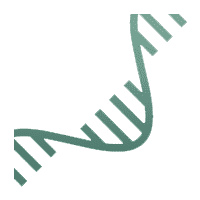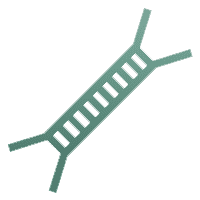Spatial Transcriptome Sequencing
Overview
Features
Project Workflow
Bioinformatics Analysis Pipeline
Demo Results
Cases & FAQ
Resources
Inquiry
Neither routine single-cell RNA sequencing nor tissue sample RNA sequencing can provide researchers with precise spatial information. The spatial transcriptome is a technology that analyzes RNA-Seq data at the spatial level to analyze all mRNA in a single tissue section and obtain transcription information at specific locations in the tissue, providing effective data support for research.
CD Genomics can help you generate all transcriptome data from complete tissue samples, so that you can locate and distinguish the active expression of functional genes in specific tissue regions, provide valuable insights for research and diagnosis, and allow scientists to detect gene expression of tissue samples. All gene activity, and map where the activity occurred. The technology has brought new discoveries that will help scientists better understand diseases and biological processes.
Overview
The workflow of spatial transcriptome sequencing is mainly divided into two parts: the histology part and the omics part. The histology part includes sample embedding, slicing, fixation, staining and imaging, and records the morphological information of the slice; the omics part includes cDNA synthesis, amplification, adaptor ligation and sequencing, and records the transcript information and spatial location information of the section. Using 10X Genomics spatial transcriptome sequencing technology, each slide used for library construction has four capture areas, where each capture area contains 5000 barcoded spots and each spot has a unique barcode sequence. The cells in the tissue section will release mRNA, and the mRNA that migrates to each spot will be marked with the corresponding barcode sequence, and then the library will be constructed and sequenced. Finally, analyze the data according to the barcode information of the data to determine which data comes from which location, so as to realize the visualization of spatial gene expression.
Single-Cell Transcriptomics vs. In Situ Sequencing vs. Spatial Transcriptomics:
|
Single-Cell Transcriptomics |
In Situ Sequencing |
Spatial Transcriptomics |
| Methodology |
Analyzes gene expression at the level of individual cells. |
Examines gene expression within intact tissue sections. |
Studies the spatial distribution of gene expression within tissues. |
| Cellular Resolution |
Provides high cellular resolution, profiling individual cells. |
Provides cellular resolution, but not at single-cell level. |
Provides spatial resolution without single-cell resolution. |
| Gene Expression Data |
Captures the expression profile of each individual cell. |
Provides expression data for regions of interest within tissue sections. |
Provides expression data for spatially defined areas of tissues. |
| Cellular Heterogeneity Analysis |
Allows the characterization of cell subtypes and states. |
Suitable for studying cellular heterogeneity but lacks single-cell precision. |
Suitable for identifying spatially distinct patterns but not cellular heterogeneity. |
| Insight into Tissue Architecture |
Limited insights into tissue architecture and organization. |
Preserves tissue architecture, making it useful for mapping gene expression within the tissue context. |
Provides information about the spatial distribution of genes within tissue regions. |
| Applications |
Identifying cell types, subtypes, and their functional states. |
Mapping gene expression patterns within intact tissues. |
Analyzing gene expression across tissue regions for understanding spatial biology. |
| Examples of Use |
Studying cell diversity in tumors, developmental biology. |
Investigating the distribution of specific genes in tissue sections. |
Exploring spatial gene expression in organs, including brain mapping. |
| Compatibility with Frozen Tissues |
Suitable for frozen cells. |
Suitable for OCT-embedded samples. |
Suitable for OCT-embedded samples. |
| Spatial Resolution |
Lacks spatial resolution. |
Offers spatial resolution within tissue sections. |
Provides spatial resolution but not single-cell resolution. |
For more information, please contact our technique team.
Features
| Flexibility |
One-stop Service |
High Quality |
Data Analysis |
| Applicable to most tissue types, verified tissues include brain, tumor, kidney, skin, heart, etc. |
From tissue sectioning to library construction, to sequencing, and to data analysis. |
Rich experience in library construction and short-read NGS guarantee high quality. |
Data preprocessing, basic analysis, advanced analysis, and customized analysis. |
Project Workflow

1. Sample Preparation
Tissue section; RNA purification; quality assessment and quantification

2. Library Preparation
Ribosomal RNA Removal
250~300 bp Insert cDNA Library

3. Sequencing
Illumina Novaseq, PE 150
≥ 80 million read pair per sample

4. Data Analysis
Visualize and preprocess results, and perform custom bioinformatics analysis.
Bioinformatics Analysis Pipeline
In-depth data analysis:
- Transcript assembly
- Transcript expression profiling and differential expression
- Manifold embedding and clustering based on transcriptional similarity
- Composition and spatial architecture of transcriptome
- Gene Identification: highlight expression of a specific gene with the spots from an individual cluster
- Data visualization includes spatial Image and t-SNE
- Statistical analysis of spatial expression patterns
Sample Requirements: Complete tissue section samples. Correct tissue processing and preparation can maintain the morphological quality of tissue sections and the integrity of mRNA transcription.
Sample storage: The prepared tissue section samples can be stored at -80°C for one week, and each slide is stored separately in a sealed container.
Shipping Method: When shipping histological samples, the sample should be stored in a sealed container. Shipments are generally recommended to contain 5-10 pounds of dry ice per 24 hours.
Deliverable: raw data as BAM files, coverage summary, QC report, custom bioinformatics analyses.
Demo Results
 Data quality control
Data quality control
 Cluster analysis
Cluster analysis
 Heat map
Heat map
 Differential gene analysis (DGA)
Differential gene analysis (DGA)
 Differentially expressed gene analysis
Differentially expressed gene analysis
Case Studies
-
Deciphering Renal Tumors through Single-Cell and Spatial RNA Sequencing
-
Renal tumors pose a significant challenge in the realm of oncology. Understanding the intricate cellular signatures within these tumors is vital for developing effective treatment strategies. In this comprehensive case study, cutting-edge single-cell and spatial sequencing technologies were employed to unravel the cellular intricacies of renal tumors. By delving into the microenvironment of these tumors and scrutinizing their molecular landscape, critical dependencies that drive tumor progression and guide therapeutic interventions are explored.
To gain insights into the renal tumor microenvironment, a meticulous analysis of over 270,000 single-cell transcriptomes alongside 100 microdissected whole exomes derived from 12 renal tumor patients was conducted. Tissue samples were obtained from various tumor regions, including the core, the tumor-normal interface, normal peripheral tissues, and peripheral blood. The findings reveal a profound connection between the spatial distribution of CD8+ T-cell clonal phenotypes and their exhaustion status. Surprisingly, the somatic cell heterogeneity within tumors is not solely accounted for by spatial heterogeneity. This innovative approach enabled ab initio mutation calling using single-cell RNA sequencing data, facilitating a broader understanding of stromal cell clonality and spectral traces of myeloid cell development.
 Sampling strategy and overall tissue distribution of the major cell types in RCC. (Li et al., 2022)
Sampling strategy and overall tissue distribution of the major cell types in RCC. (Li et al., 2022)
The key findings of the study unveil the multifaceted cellular features of renal tumors and classify cancer cells based on their functional attributes. Notably, a more aggressive phenotype at the tumor-normal interface, where the tumor separates from the normal kidney, was discovered. This aggressiveness appears to be driven by IL1b signaling in macrophages, indicating the pivotal role of this cytokine in tumor progression.
FAQ
-
Why choose spatial transcriptomics?
-
Spatial transcriptomics serves as a vital bridge, seamlessly connecting the realms of traditional transcriptomics and single-cell RNA-seq. By scrutinizing the transcriptome of individual cells within a tissue section immobilized on a microarray, it not only unveils the expression of 1-20,000 genes within the sample but also elucidates alterations in gene expression across diverse tissue regions and the spatial relationships among distinct cells. This cutting-edge approach to spatial transcriptomics has found extensive utility in the fields of immune infiltration research, tumor investigations, and the exploration of underlying disease mechanisms.
-
What types of samples are suitable for spatial transcriptome analysis?
-
A wide range of samples can be considered for spatial transcriptomics, including various organs from humans, mice, rats, and even samples from other mammalian species. However, it's essential to be aware of potential challenges. To maximize the success rate of your analysis, we recommend initially collecting samples for tissue freezing and embedding, followed by rigorous quality control. This approach typically yields higher-quality data. If you have different types of samples in mind, don't hesitate to reach out to our technical support team.
-
What is the difference in parameters between 10X Visium OCT samples and FFPE samples?
-
|
OCT Sample |
FFPE Sample |
| Degree of RNA Degradation |
Low |
Higher |
| Permeabilization Difficulty |
Large, may require pre-compacting |
Small, no pre-experimentation required |
| Species Limitation |
None |
Human and mouse only |
| Quality Control Standards |
RIN > 7 |
DV200 > 50% |
| Slice Area |
6.5 mm x 6.5 mm |
6.5 mm x 6.5 mm |
| Gene Type |
Oligo-dT capture mRNA |
Human: 18,000; Mouse: 20,000 = 25,000 reads/spot |
| Data Penalty |
50,000 reads/spot |
50-100 G |
-
What should I pay attention to in the preparation and preservation of spatial transcriptome tissues?
-
Freezing followed by Embedding
- Begin by swiftly rinsing fresh tissue samples with pre-cooled PBS or saline to remove any surface residues.
- Blot excess liquid with absorbent paper.
- Immerse the fresh tissues in pre-cooled isopentane using forceps and snap-freeze them for approximately 1 minute, adjusting the freezing time based on tissue size and morphology.
- Transfer the frozen tissues to a pre-cooled WHEATON CryoELITE cryovial and place it on dry ice.
- Store the frozen tissue at -80°C for long-term preservation or proceed directly to the next step of OCT embedding.
Simultaneous Embedding and Freezing
- This method is suitable for very soft tissues, such as embryos, that require liquid support to maintain their normal morphology. It doesn't involve the use of isopentane.
- Embed and freeze the tissue simultaneously.
The freezing and embedding methods are not limited to the above two methods, but other methods can be consulted.
-
Is it possible to conduct a spatial transcriptome analysis on tissue samples that have been frozen directly in liquid nitrogen and stored for an extended period of time?
-
Freezing samples in liquid nitrogen can lead to the formation of ice crystals on the tissue's surface, potentially impacting its structural integrity. Additionally, there's a risk of RNA degradation during long-term storage. In such cases, it is first recommended that if the sample can be re-obtained, it is best to re-prepare it with pre-cooled isopentane embedding. If the sample was collected in the early stage and cannot be re-obtained in the later stage, the sample can be sectioned and tried. Generally, 10 sections are cut first for RNA quality control test (Refer to our Sample Submission Guidelines), if the quality control is qualified, the sections can be HE stained, and the staining results can be used for subsequent experiments. If the structure is severely damaged, then even if the RNA quality is intact, subsequent experiments cannot be performed.
-
What are the criteria for tissue size in spatial transcriptome analysis?
-
Visium Chip used for spatial transcriptome has a capture area of 6.5mm x 6.5mm. To maximize the efficiency of the Visium Chip, it's essential to determine the ideal sampling location and appropriate tissue size before sample selection. Consequently, when it comes to sample size, it is preferable to have it match or exceed the capture area. In cases where the sample is larger than the capture area, it might be feasible to consider dividing it into two capture areas. However, for samples smaller than the capture area, accommodating more than one sample in a single area can be challenging and may require a trial-and-error approach.
-
Does spatial transcriptome analysis operate at the single-cell level?
-
No, it does not. The spatial transcriptome detection takes place at a larger scale. Visium chip consists of capture areas measuring 6.5 mm x 6.5 mm, each containing 5,000 spots. The number of cells within each spot can vary depending on the sample type, typically ranging from a dozen to tens of cells. Consequently, spatial transcriptome studies are generally complemented with single-cell transcriptome data for combined analysis.
-
Is it possible to analyze samples from various tissue types on a single chip?
-
We discourage this approach for several reasons. Firstly, different tissue types demand unique permeabilization conditions for testing, and combining them on a single chip raises the risk of cross-contamination during the embedding process. Moreover, attempting to consecutively apply multiple tissue slices to the chip can be challenging and poses risks. This is mainly due to the requirement of swift tissue application to the chip in preparation for the subsequent steps of the experimental procedure.
References:
- Li, Ruoyan, et al. "Mapping single-cell transcriptomes in the intra-tumoral and associated territories of kidney cancer." Cancer Cell 40.12 (2022): 1583-1599.
* For Research Use Only. Not for use in diagnostic procedures.





 Data quality control
Data quality control
 Cluster analysis
Cluster analysis
 Heat map
Heat map
 Differential gene analysis (DGA)
Differential gene analysis (DGA)
 Differentially expressed gene analysis
Differentially expressed gene analysis
 Sampling strategy and overall tissue distribution of the major cell types in RCC. (Li et al., 2022)
Sampling strategy and overall tissue distribution of the major cell types in RCC. (Li et al., 2022)
